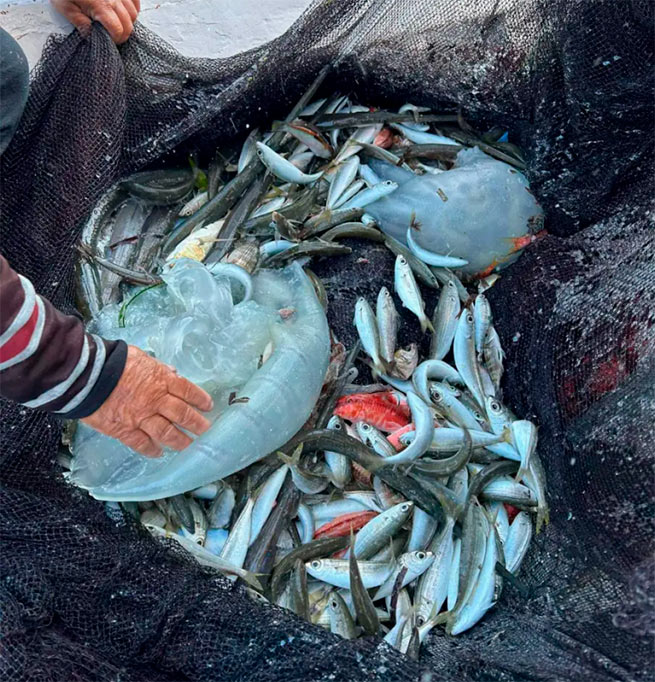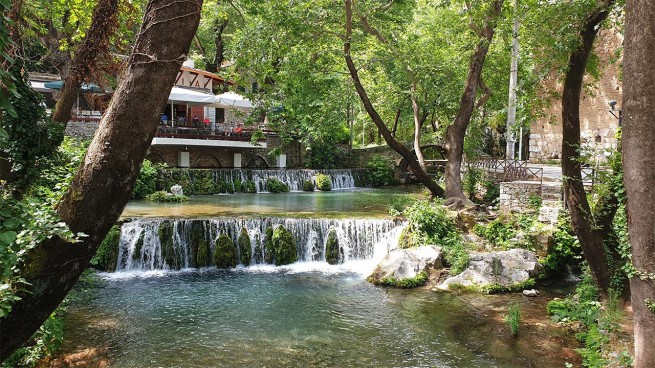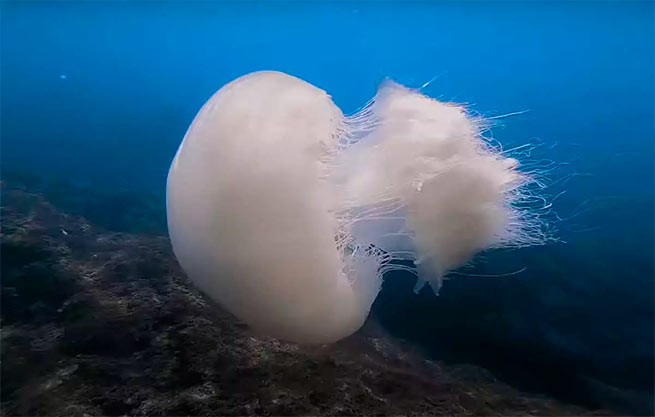Poisonous jellyfish which is found only in the Red Sea, was discovered off the island of Rhodes. Experts are talking about the consequences of the climate crisis, which is why endemic species from the Red Sea are leaking into the Mediterranean through the Suez Canal.
The Hydrobiological Station of Rhodes made a statement on this matter, including warning to the public.
The species Medusa Rhopilema Nomadica reaches a diameter of one meter, and people should avoid it. It is light blue in color and the bell has a round shape. It can grow up to 10 kg in weight, and its bell is usually 40-60 cm in diameter, but can reach 1 meter.
Rhopilema nomadica, also known as the nomadic jellyfish, is hemispherical in shape, transparent bluish in color, and can reach 1 meter in diameter. On the lower surface of the body there are 8 tentacles with threads, that is, small stings with poison, which, when in contact with the skin, cause severe pain, burning, itching and irritation.
The European Union lists it as one of the worst invasive marine species in European waters. This particular jellyfish is usually endemic to the Red Sea and is making its way through the Suez Canal into the eastern Mediterranean, where temperatures have risen by 3 degrees. Their numbers are growing because the number of sea turtles, for which they are the main food, is declining.
A species of jellyfish, relatively rare in the Greek seas, was discovered in Rhodes in the last 24 hours, indicating the consequences of the climate crisis in our region, reports the Hydrobiological Station of Rhodes.
As stated in the report of the Hydrobiological Station of Rhodes, this species is endemic to the Red Sea, and was first recorded in the Mediterranean in 1970. Since 1980, it has appeared periodically in Greek seas, with warnings issued to citizens to avoid contact as they are highly poisonous.
In recent years, the Greek seas have seen massive invasion of jellyfish. These are tropical or subtropical species, most of which began to invade Mediterranean waters after the construction of the Suez Canal in 1869.
In fact, the species alien to the Mediterranean ecosystem were called Lessepsian immigrants, taking their name from the French canal engineer Ferdinand Lesseps. The Mediterranean Sea reportedly hosts the largest number of biological invasions in the world.
Post of the hydrobiological station of Rhodes with information for the public
Employees of the Rhodes Hydrobiological Station noticed 4 individuals of Rhopilema nomadica on March 11 and 12 in Triantos Bay.

Even if you find a jellyfish on the beach, avoid touching it with your bare hands! In case of skin contact, take the following steps:
- Do not touch the jellyfish with your bare hands.
- Rinse with salt water or vinegar, but do not scrub the area. Do not use fresh water!
- Do not apply bandages.
- Because symptoms may vary from person to person, do not use pharmaceutical medications without consulting your doctor.
- If pain and swelling persist, consult a doctor.
- In case of an allergy, a person should immediately consult a doctor or hospital.
Since the 1980s, outbreaks of jellyfish numbers have been periodically recorded in Greek seas. This phenomenon is transient, usually lasting from several hours to several days and depending mainly on sea currents. At the same time, an increase in global and, accordingly, sea temperatures due to climate change creates favorable conditions for the occurrence of such outbreaks in jellyfish populations.
It is characteristic that in previous years the sea temperature on the coast of Rhodes in the period February-March was usually 16°C, while this year for the same period the temperature is almost 19°C!
In addition, the decrease in the number of sea turtles, for which jellyfish are the main food, contributes to an increase in the jellyfish population.
In case of detection of such jellyfish, please report it to the Hydrobiological Station of Rhodes through our page Rhodes Aquarium – Hydrobiological station – HCMR or by email (The email address is protected from spambots. Javascript must be enabled in your browser to view the address.).







More Stories
Landslide on Santorini
D. Sariyannis: “We expect African dust in mid-May”
Dust from the Sahara: first results of analysis of chemical components